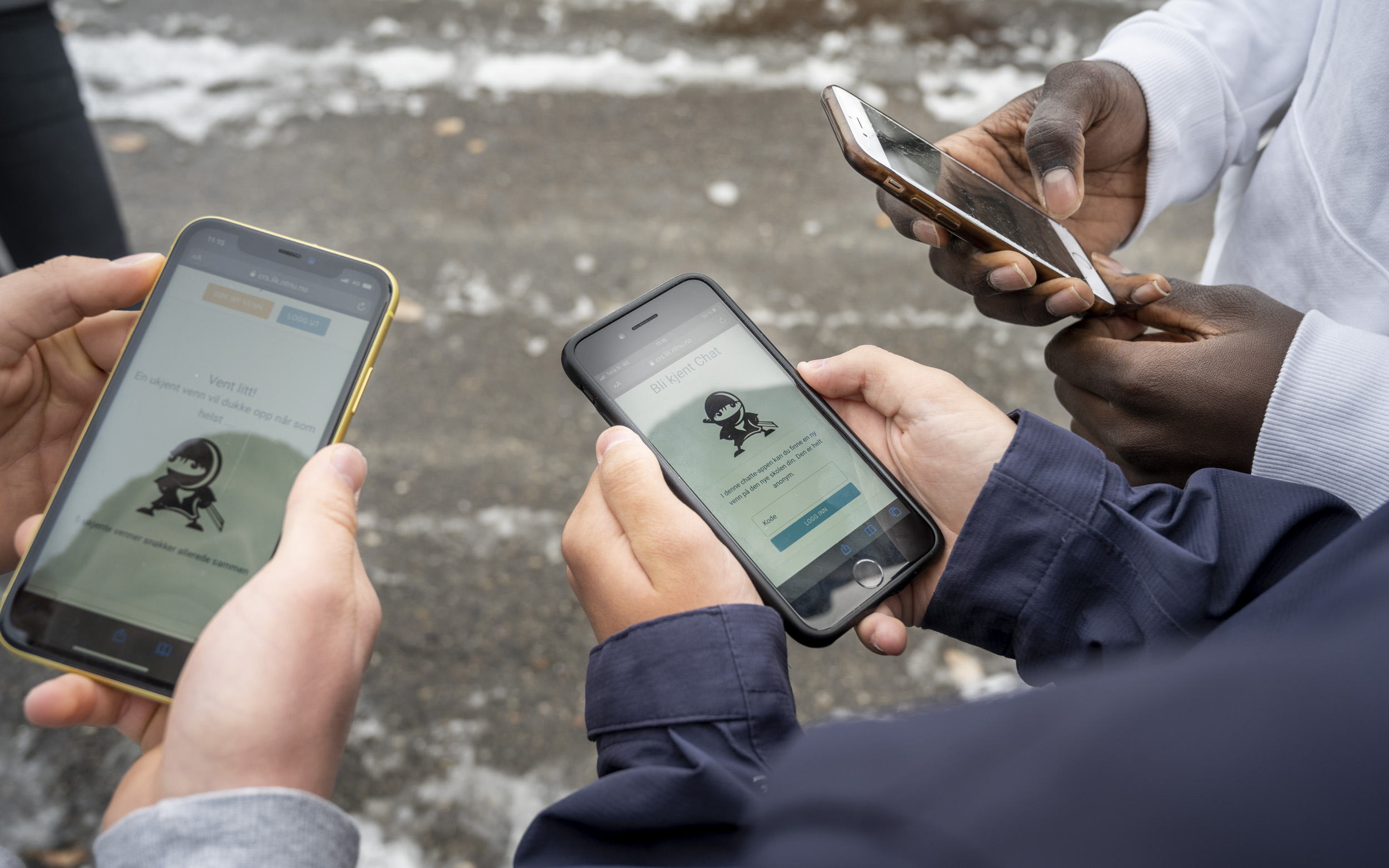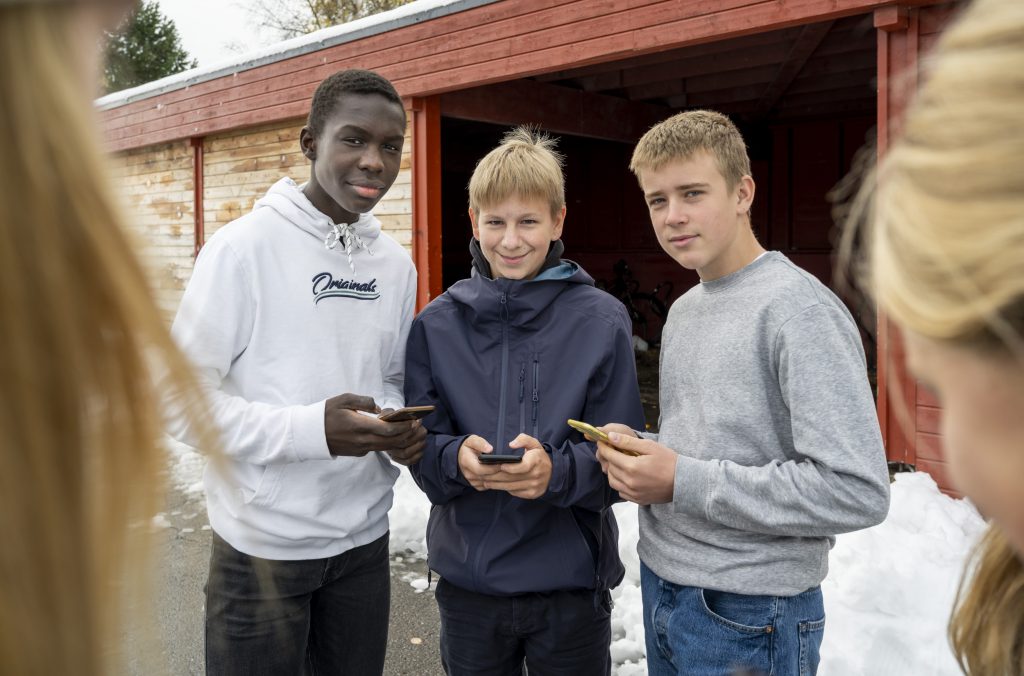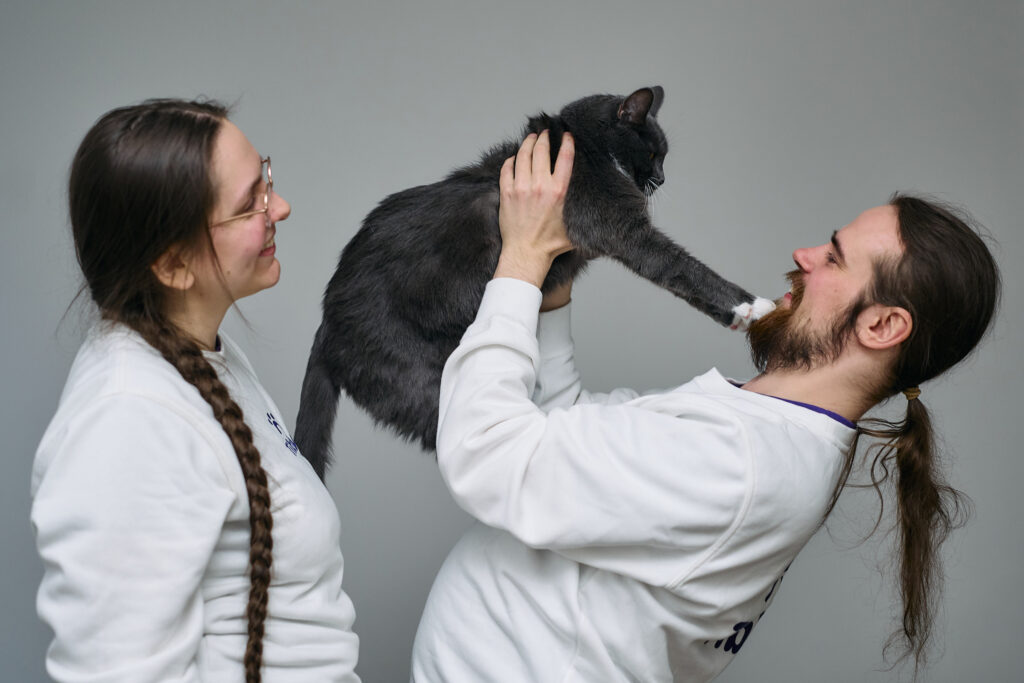AiBA – avslører cybergrooming
Tekst: Anne-Lise Aakervik
Foto: synlig.no
Millioner av mindreårige barn logger seg daglig på chatterom der de tror de møter andre 12-åringer. Men det kan godt være en mann bak profilen til en 13 år gammel jente med langt skumlere hensikter enn en prat om «My little Pony». Dette håper Patrick Bours i AiBA å forhindre.
.

Slik ser app’en som niende klassene på Kopperud skole i Gjøvik bruker for å bli kjent med elever på andre skoler. Det gir også forskerne relevant informasjon om hvordan algoritmene fungerer i forhold til å avsløre hvem som skriver.
.
Cybergrooming heter det når voksne ta kontakt med barn på nettet via en falsk profil. Formålet er ofte å få barna over på en privat kanal for at barna skal sende bilder av seg selv, med og uten klær, eventuelt vise seg frem, og etter hvert kunne lokke barnet til et møte.
Høsten 2019 fikk professor og forsker Patrick Bours ved NTNU Gjøvik i samarbeid med NTNU Technology Transfer AS, Discovery-midler til å bygge verktøyet og verifisere teknologien mot industriaktører. Nå står AiBA foran sin første verifisering, og skal trene opp systemet med hjelp fra niende klassinger på tre skoler i Gjøvik.

Moro, men rart å chatte med noen vi ikke kjenner, sier fra venstre Erle Mo Rud, Ingrid Flermoen og Matilde Baade Larsen,
Men slapp helt av. Disse niende klassingene skal bare chatte med elver på andre skoler i et lukket system, gjennom en «bli kjent app». Hensikten er å trene systemet i et chatterom med mange unge, brukere. En positiv sideeffekt av dette er at elevene blir satt i kontakt med helt vilkårlige elever fra andre skoler som de ikke kjenner, men som de kommer til å møte på ungdomsskolen neste år.

Patrick Bours er professor i informasjonssikkerhet ved NTNU Gjøvik og hadde ideen til verktøyet som kan avsløre overgripere på nettet. – Jeg har to mindreårige barn, og jeg ser med bekymring på hvordan barna sendes på nett med risiko for å gå i armene på folk som jakter barn de vil møte. Det kan vi ikke gjøre, slår Bours fast.
Det lyser rødt
Nettet flommer over av chattetjenester og apper som sender meldinger mellom to personer, og millioner av samtaler pågår døgnet rundt. Å kontrollere dette for å hindre at overgrep skjer er umulig for moderatorer som følger med manuelt. Det er behov for mer automatikk og noe som varsler om pågående samtaler. Her kommer AiBA inn, sier Bours.
– Vi har utviklet et system med flere algoritmer kan gi de store chatteselskapene et verktøy til å plukke ut de samtalene som bør sjekkes opp, når de pågår og ikke i etterkant, når kanskje skaden er skjedd og overgrep begått. Den fungerer som en varsellampe. Ved maskinlæring gjør systemet analyser av samtalene, og risikovurderer den ut fra bestemte kriterier. Nivået går kanskje litt opp og ned gjennom samtalen da systemet risikovurderer hver eneste melding. Når det blir for høyt, lyser det rødt. Da varsles moderatoren som går inn i samtalen og vurderer.
Vet at det finnes
I disse dager samles altså data fra hundrevis av elever som chatter for å sikre at algoritmene trenes med riktige datasett.
I skolegården på Kopperud skole er det stille. Det nærmer seg friminutt, og vi har fått lov til å snakke med seks ungdommer som har hatt sin første time med «bli kjent appen» enten på mobilen eller på Ipad.
– Det var gøy, sier Adrian H. Flatmo
– Ja og litt merkelig, for vi visste jo ikke hvem vi snakket med, og ikke helt hva vi skulle snakke om eller, sier Matilde Baade Larsen.
– Det ble mest hei, og hva heter du og sånn, sier Elias Strand Olsen.
Alle sier de vet at det skjer cybergrooming – men de har ikke vært bort i det, tror de.

Godwill Ambrose. Elias Strand Olsen og Adrian H. Flatmo synes det er spennende å bruke app’en. De er ofte på pratekanaler og blokkerer folk de ikke kjenner eller ikke vil ha kontakt med.
– Vi hører om det mange steder, sier Erle Mo Rud.
–Hva gjør dere da, hvis dere får mistanke?
– Vi bare blokkerer den personen. Og hvis vi blir kontaktet av ukjente er vi jo litt på vakt, vi vet jo mer enn de voksne om dette, påstår Godwill Ambrose.

Lærer Kristin Tokerud lærer også mye nytt ved at klassen deltar i dette prosjektet. Det er ingen tvil om at ungene er lengre fremme teknisk enn oss voksne, men vi ser raskere konsekvensene.
Lærer Kristin Tokerud synes det er spennende å få lov til å bidra til dette prosjektet. – Jeg ble nysgjerrig. Cybergrooming var et nytt felt for meg, og jeg visste ikke at mange etablerer et tillitsforhold over tid. Da er det også vanskelig for barnet å vite hvor alvorlig det er, og kan bli.
Hun sier at elevene er stort sett lengre fremme enn de voksne på nettet når det gjelder mulighetene. Ungdommene vet godt hva de ikke skal gjøre, men kanskje er det vanskeligere å huske på det hvis de sitter alene på rommet sitt.
Hva er atferdsbiometri
Patrick Bours er ekspert på atferdsbiometri og det er dette som danner utgangspunktet for algoritmen. Biometriske kjennetegn kan beskrives som kjennetegn som utgår fra kroppen, som er unike for deg som enkeltperson og samtidig permanente eller stabile over tid. De mest kjente formene for biometriske kjennetegn er fingeravtrykk, håndavtrykk og ansiktsform, samt de to øyeteknologiene netthinne- og irisavlesning. Men også stemmegjenkjenning og tastefrekvens kan benyttes.
Dette siste er altså utgangspunktet for verktøyet og handler om hvordan du bruker tastaturet, rytme og slagkraft. Det kan gi forskerne nok informasjon til å kunne fastslå om du er mann/kvinne, ung/gammel i over 80 % av tilfellene. Og hvis man samtidig legger til hvilke ord de i bruker så gir det over 90% gjenkjenning av kjønn og alder.
– Hensikten er å avsløre en overgriper så raskt som mulig, sier Bours. – Det er gjerne mange samtaler over tid det dreier seg om, så når systemet oppdager dette kan vi varsle raskt. Det er også mulig å si fra til barnet i chatten at dette er ikke Pia på 13, men en voksen mann på 40 du snakker med.
Stor interesse
Når forskerne sammenligner de forskjellige plattformene så oppdager de at brukerne skriver annerledes på f.eks. snapchat enn på MovieStarPlanet og andre. – Så dette må vi ta høyde for når vi trener algoritmen. Det samme med språk. Tjenesten skal kunne utvikles på alle typer språk, sier Bours.
De har jobbet mot en danske chatteplattform som heter MovieStarPlanet. Her er det hundretusenvis av barn som chatter daglig. – Og vi er lovet data fra denne tjenesten til å trene på.
AiBA har samarbeidet med flere gamingselskaper i utviklingen og det er interesse for å installere algoritmen. Noe som kan være på plass neste år.

Hege Tokerud fra NTNU Technology Transfer har stor tro på AiBA. – Dette er nå et kommersialiseringsprosjekt Patrick Bours jobber 50% med fokus på det tekniske og jeg jobber 50 % på marked. Totalt består teamet av 8 personer.
Prosjekter og nyheter
Kontakt:
Prosjektleder
Jan Hassel
Epost: jan.hassel@ntnu.no
Telefon: 906 53 180
Kontor: Hovedbygget, sokkel
Håvard Wibe
Epost: havard.wibe@ntnu.no
Telefon: 41 47 37 68
Kontor: Hovedbygget, sokkel







